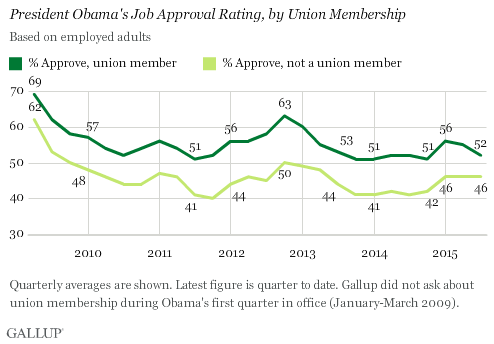Story Highlights
- Near personal 51% low for Obama
- Union members have consistently had higher approval for Obama
- Gap between union members and nonmembers is smallest to date
PRINCETON, N.J. -- Leading into this year's Labor Day holiday, 52% of U.S. union members approve of President Barack Obama's job performance, down slightly from 56% in the first quarter of 2015 and one percentage point above his personal low among this group. At the same time, the average rating of the president among those who are not union members has been flat at 46%.

Throughout Obama's presidency, union members have consistently been more likely than nonmembers to approve of the job he is doing, but if these figures hold through the rest of the third quarter, the current six-point gap would be the lowest of his presidency.
The latest figures are based on July 1-Aug. 30 Gallup Daily tracking interviews with 2,684 employed adults who are members of unions and 23,111 employed adults who are not union members. Given the large proportion of Americans who are not union workers, Obama's approval rating among all Americans during this time is also 46%.
Union members are a core Democratic constituency, so it is not surprising that they have been more approving than nonmembers of the job Obama is doing. Obama's job approval rating has averaged 55% among union members since Gallup began tracking approval among this group in the second quarter of 2009. That compares with a 46% average among nonmembers, and 47% among all Americans.
Obama's approval rating among union members has held above the majority level each quarter, with the lows of 51% coming on four separate occasions, most recently in the fourth quarter of 2014.
Other than the 69% recorded during the "honeymoon phase" of his presidency, Obama's approval among union members has been as high as 63%. This occurred during the fourth quarter of 2012, which coincided with his re-election victory.
Currently, his approval rating is an identical 52% among union members who work for the government and union members who work for private-sector employers. Government union workers and nongovernment union workers have typically shown little to no difference in their approval ratings for Obama.
Gap Between Union Members and Nonmembers on Pace to Be Smallest
The trend lines in Obama's approval ratings among union members and nonmembers have risen and fallen together over the six-plus years of his presidency, but with union members' ratings consistently higher, by between seven and 13 points. The smallest gaps prior to the current quarter were seven points during Obama's second quarter, from April-June 2009 (69% union to 62% nonunion), and from April-June 2013 (55% to 48%).
One key reason union members' approval may be lower this quarter could be the president's pursuit of free trade agreements with Asian nations. Labor unions typically oppose free trade agreements because of concerns that cheaper imports could result in job losses for American workers.
Also, more of the political attention now is focused on the 2016 election, and Democratic candidates like Bernie Sanders and Hillary Clinton may be talking more about issues union members care about than the president is. In particular, the president's top agenda item at this point is marshaling congressional support for the nuclear agreement with Iran.
One factor that may be preventing Obama's approval among union members from being even lower is that he has taken a number of steps in recent months aimed at expanding workers' rights. Included among these are making an expanded number of workers eligible for overtime pay and attempting to have more workers classified as employees rather than contractors, to make them eligible for greater legal protections.
Union members' approval of Obama was particularly high relative to nonmembers' in 2012, as Obama was campaigning for a second term. In the third and fourth quarters of that year, union members' approval averaged 13 points higher than that of nonmembers.
Implications
Union members have solidly backed Obama throughout his presidency, showing approval nearly 10 points higher than the national average. But their current 52% support for him is on the low end of what Gallup has measured -- just one point above his personal low.
Previously, his low points in union-member approval came when his overall approval rating had also been at personal lows, suggesting union members' less positive evaluations at those times were based on the same factors causing other Americans to view him less positively. The current decline in union approval is different because his overall approval rating has been relatively stable at 46%, about five points above his personal low. This suggests the decline in union-member approval in recent months may be a reaction largely confined to this group, possibly in response to the president's actions or policies on trade and his focus on issues of less direct benefit to union workers.
Historical data for this question are available in Gallup Analytics.
Survey Methods
Results for this Gallup poll are based on telephone interviews conducted July 1-Aug. 30, 2015, on the Gallup U.S. Daily survey, with a random sample of 25,795 working adults, aged 18 and older, living in all 50 U.S. states and the District of Columbia. For results based on the total sample of national adults, the margin of sampling error is ±1 percentage point at the 95% confidence level.
For results based on the sample of 2,684 employed union members, the margin of sampling error is ±2 percentage points at the 95% confidence level.
For results based on the sample of 23,111 employed non-union members, the margin of sampling error is ±1 percentage point at the 95% confidence level.
Learn more about how Gallup Daily tracking works.
